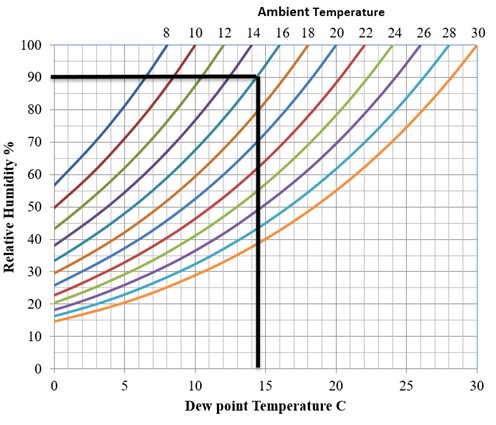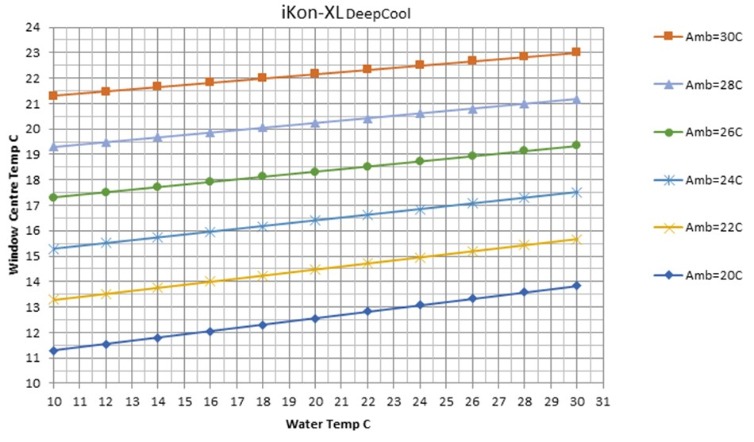Resources
 Part of the Oxford Instruments Group
Part of the Oxford Instruments Group
Expand
Collapse
 Part of the Oxford Instruments Group
Part of the Oxford Instruments Group
The specification sheets of popular Andor astronomy detectors such as Balor, Marana, iKon-L and iKon-XL state operational ranges of environmental ambient temperature and humidity.
An example of such stated ranges is shown here for the Balor large area sCMOS platform:
While it is recommended that the detectors be operated within the stated ranges under normal use, the purpose of this letter is to further explain these environmental ranges and outline how they may be exceeded by experienced operators under well controlled conditions.
The lower limit of the environmental temperature is normally dictated by the ambient temperature to which key electronic components are formally rated, such as FPGA. Some of our cameras have been formally qualified to lower temperatures, meaning they have been formally tested at that temperature in an environmental chamber to verify that there are no power-up issues (‘cold start’). If a mechanical shutter is involved, the lower temperature limit can also be dictated by that component. For example, the iKon-XL CCD platform has been formally qualified for use down to -30°C by utilizing a particular shutter that is rated to this temperature.
It is feasible to operate Andor cameras below their stated lower temperature limit, but it may come at the risk of the camera failing to operate while at the non-compliant temperature. It is however unlikely to cause irreparable damage to the camera.
Furthermore, if the camera were already powered up (for example during the day in the observatory) and then the ambient temperature dropped significantly, the camera would to some extent be self-heating, so all the electronics may not experience the same cold ambient temperature and camera operation can remain unaffected. These operating conditions should be thoroughly tested and controlled however, particularly if the camera is to be operated in a remote unmanned location. By way of example, we can confirm that one of the iKon-XL cameras has been used successfully down to -88°C in Antarctica. In this extreme condition, the camera was powered up at -30°C or above, but allowed to subsequently operate down to -88°C ambient during which it continued to successfully image. We are not guaranteeing all models of Andor cameras will operate at such extreme temperatures, but it is a relevant reference point nonetheless.
If using liquid cooling, the ambient lower temperature should also be considered in the context of avoiding freezing of cooling fluid and subsequent damage. A water/glycol mix is recommended to mitigate such risk.
The upper ambient temperature limit also needs to be considered. Going beyond the upper temperature range may make it difficult to reach the target cooling setpoint of the sensor, especially when using fan cooling (as opposed to liquid cooling). In sCMOS cameras in particular, if the sensor cooling setpoint cannot be reached due to higher ambient temperature, it is possible that image quality may be compromised. This is because sCMOS cameras store various correction maps in memory that are used to normalize fixed pattern noise sources in the raw images. However, these correction maps can be temperature dependent; thus, variance from set sensor temperatures can adversely affect the extent to which fixed pattern noise is corrected.
Further care needs to be exercised if ambient temperature is allowed to exceed +50°C, in that for example, adhesives that are used in the camera may start to degrade. Note that we generally state +50°C as an upper limit for camera storage and it is best not to exceed this temperature during operation either.
What happens if we allow the camera to exceed maximum temperature for a given cooling set point? There is a temperature sensor inside Andor cameras that is continually monitoring internal temperature – if it reaches a certain threshold, then a warning buzzer will sound. While the buzzer is sounding, the camera will no longer be functional and is unable to acquire data. If the internal heat continues to increase further, then the camera power will automatically switch off as a safety mechanism. If this happens then a ‘power cycle’ is required to reactivate the camera. If in a remote unmanned location, such an eventuality should be factored in by way or remotely cutting and reconnecting power to the camera.
The upper humidity guideline exists primarily to reduce the risk of condensation when using cooling fluid that is below the adjacent air dew point. Fluid cooling that is below the dew point will cause internal condensation, possibly damaging the electronics permanently. The key point to avoid permanent damage with liquid cooling, is that the conditions should be non-condensing. If the customer is fully aware of these risks and manages them accordingly, then by all means the cameras can be used under humidity conditions that exceed the stated guide.
For example, Andor specify usage of iKon-XL cameras in environments up to 70% (non-condensing).
The phrasing ‘non-condensing’ is vital context and can be used as a guide to judge whether you can reasonably use the camera in environments beyond 90% humidity. Simply put, we would only say that you can use the cameras in up to 90% humidity (or higher) if you can still guarantee non-condensing conditions.
The reference plot shown in Figure 1 can be used as a guide to judge whether or not elements of the camera are at risk of condensation forming in different combinations of humidity and ambient temperature. The example indicated is for 90% humidity and 16°C ambient. The corresponding Dew Point is 14.5°C, and we would therefore recommend that all components of the camera are at least 2 degrees above the Dew point, therefore they should be 16.5°C or above.

Figure 1: Dew point reference plot, showing dew point as a function of ambient temperature and relative humidity.
Finally, conditions of high humidity can heighten the risk of condensation appearing on the window. Even though Andor vacuum cameras do not have convention currents in the sensor chamber, radiative cooling can still cause the window temperature to drop below ambient temperature. Window humidity will temporarily affect viewing, but can be mitigated by, for example, creating a desiccated air space in front of the window. By way of illustration, the plots in Figure 2 show window temperature as a function of ambient temperature and liquid coolant temperature for the iKon-XL CCD platform in ‘Deep Cooled’ build configuration (which uses exclusively liquid coolant to dissipate heat from the Peltier coolers).

Figure 2: Window temp (measured at window centre) as a function of ambient temperature and liquid coolant temperature.
We hope this brings further clarify to how Andor’s cameras can be used under carefully controlled observing conditions and enhances the flexibility of their intended usage. Andor take pride in producing high-performance and high-quality detector solutions, with operational longevity and low maintenance very much at the forefront of our design ethos, are very willing to work with you in helping to expand their applicability.
